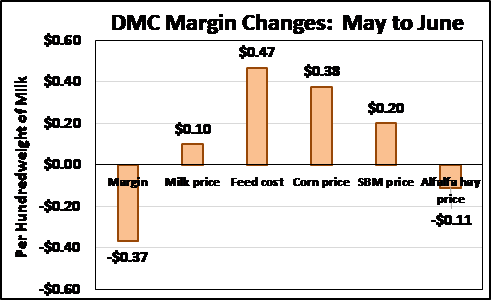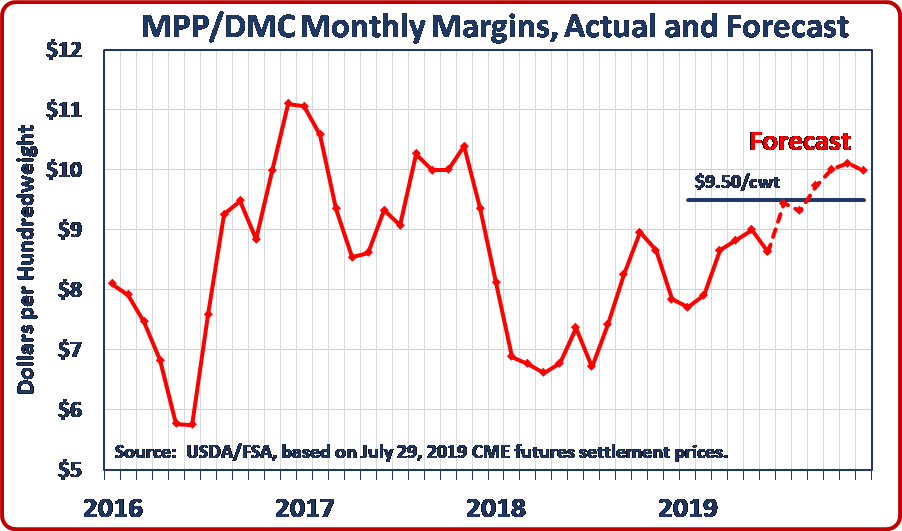Milk Producers Gain in Second Round of Trade-Mitigation Payments
August 05, 2019Milk producers will do better the second time around than they did in the first round of Market Facilitation Program payments, which the U.S. Department of Agriculture announced July 25.
The trade-mitigation payments are the key component of the $16 billion aid package the White House has offered, intending to compensate agricultural producers for lost and diminished export markets resulting from the trade policy wars.
MFP payments will be made in up to three tranches, with the second and third tranches to be determined as market conditions and trade opportunities dictate. For dairy farmers, the payment rate is $0.20/cwt., compared to a $0.12 rate used in 2018. The first tranche will include 50% of the total payment, which for dairy farmers should mean an initial rate of $0.20/cwt. on half of their production history. The other 50% will be divided between the following two tranches. If conditions warrant, the second and third payments will be made in November and January 2020. USDA will begin issuing the first payments in mid-to-late August.
The higher rate for dairy is a welcome development and reflects NMPF efforts both last year and this one to convince the administration that losses suffered by dairy farmers have been greater than the compensation provided to them.
While an improvement over the first MFP payments, NMPF still expressed concerns over details of the new program and will work with USDA to implement the initiative in as pro-farmer a way as possible. NMPF opposed USDA’s continued use of dairy farms’ outdated production history in assessing payments and will continue working with the agency and allies in Congress to push the USDA to update that data.
“We appreciate the efforts of USDA and the White House to assist farmers who have suffered significant losses due to retaliatory tariffs,” NMPF President and CEO Jim Mulhern said. “Dairy producers have so far lost more than $2.3 billion in revenues since tariff escalation began in earnest one year ago. USDA’s new approach raises the level of aid to dairy farmers from last year’s program, a step in the right direction. We also urge the department to revise the outdated production history information used to calculate payments, because these old production numbers lessen the effectiveness of the program.”
In addition to the direct payments, USDA will spend$1.4 billion to buy commodities and redistribute them to food banks, school cafeterias and other nutrition programs, including $68 million of milk. Another $100 million is earmarked for food and farm groups, including the U.S. Dairy Export Council, to develop new export markets. MFP signup at local FSA offices will run from Monday, July 29 through Friday, December 6, 2019.
The second round of government assistance for farmers, and the inability of the aid package to replace the near-term losses for dairy, shows the need for resolution to the trade wars, Mulhern said.
“Today’s announcement underscores that dairy farmers need to rely on trade, not aid, to prosper in a global marketplace,” he said. “Resolving the current trade impasse with China and aggressively expanding ties with other trading partners also is essential to make these aid packages unnecessary. We are also working with the administration and Congress to pass USMCA, which would immediately create new opportunities for U.S. dairy.”
NMPF Heralds First Round of DMC Assistance
August 05, 2019In welcome news for dairy producers, the U.S. Department of Agriculture met its projected timeline of beginning payments under the Dairy Margin Coverage program by early July. NMPF thanked Agriculture Secretary Sonny Perdue for meeting its stated goal.
“DMC aid represents significant improvement from previous programs, and with dairy farmers facing a fifth year of low prices, receiving better assistance in a timely fashion is a matter of survival for some family farms,” said Jim Mulhern, president and CEO of the NMPF. “The DMC program doesn’t replace a healthy market, but it is a crucial safety net in turbulent times. All dairy producers should strongly consider enrolling, and to look closely at coverage at the $9.50 maximum level.”
More than one-third of all U.S. dairy farms have signed up for DMC since it was rolled out June 17, according to USDA. Enrollment will continue through Sept. 20, and coverage is retroactive to Jan. 1. NMPF has a resources page on DMC and other dairy assistance programs on its website.
June DMC Payment Higher than May as Feed Costs Push Down Margins
August 05, 2019The margin for June under the Dairy Margin Coverage program will be $8.63 per cwt, $0.37 per cwt lower than a month earlier, as rising feed costs negated any economic gains created by a higher milk price. The falling margin will generate a June DMC payment of $0.87 per cwt for producers who purchase coverage at the DMC maximum level of $9.50 per cwt for up to 5 million pounds of production history. Thus far, margins under maximum DMC coverage would generate a payment for every month of 2019.

The All-Milk Price in June was up by 10 cents a hundredweight over May, but the June feed cost calculation was $0.47 per hundredweight higher than a month earlier, as the effects of this year’s weather disruptions in the heart of the country began to take effect began to hit feed prices. On a per hundredweight of milk basis, the calculated feed cost for June rose 38 cents from May because of higher corn prices and 20 cents due to a higher soybean meal price, offsetting a decline of 11 cents in the average alfalfa hay price.
The June feed cost would have been 16 cents a hundredweight of milk lower, raising the June margin and lowering DMC payments by the same amount, had the dairy quality alfalfa pay price not been added into the calculation.
As of July 29, USDA’s DMC Decision Tool, which can be accessed online, projected the margins shown below. These calculations would generate payments averaging $0.51 per cwt., net of sequestration, for all of 2019 to producers who sign up for $9.50 per cwt coverage on up to 5 million pounds of production history. Coverage at this level costs $0.15 per cwt for a one-year signup, or $0.1125 for the year, if signing up for five years. Producers have until September 20th for 2019 enrollment.
NMPF’s DMC information page on its website offers a variety of educational resources to help farmers make better use of the program.

NMPF Encourages Government Collaboration to Support Dairy Exports
August 05, 2019NMPF and its USDEC colleagues sent a letter July 12 to FDA and USDA encouraging the agencies to negotiate and make final a Memorandum of Understanding (MOU) establishing a smooth-functioning interagency process to support dairy exports, citing the indispensable role such exports play in supporting U.S. dairy farms.
“A successful MOU should outline key roles and responsibilities of each agency in order to foster the ability of the agencies to work in a collaborative manner on the various tasks involved in keeping American-made dairy products flowing freely abroad,” NMPF and USDEC wrote.
FDA has taken proactive steps in recent years to work in conjunction with USDA and better support the U.S. dairy industry in facilitating exports around the world. But more work remains.
Without careful coordination within the dairy industry, disagreement and communication breakdowns can derail export avenues. The MOU would tackle this challenge and proactively eliminate obstacles to expanding trade opportunities for the U.S. dairy industry.
United for USMCA: NMPF Members Advocate for Free Trade
August 05, 2019focused on the importance of trade to agriculture and the need for Congress to quickly pass USMCA, focusing on the dairy industry.
In his remarks, Pence recognized CDI members Jim Wilson, Johnny Fagundes III, and John Fagundes IV and highlighted the benefits that USMCA will bring to our nation’s dairy farmers.
“I have to tell you, I watched this president drive a hard bargain,” on dairy during USMCA negotiations with Canada, Pence said. “The USMCA is a win for American dairy.”
Also as part of USMCA advocacy, Northwest Dairy Association Board Chairman and NMPF executive committee member Leroy Plagerman recently hosted a Farmers for Free Trade event at his family farm near Ferndale as part of the nationwide #MotorcadeForTrade.
NMPF is encouraging its members to take the opportunity to engage their representatives while they are in their home districts in August to emphasize the dairy-specific benefits of USMCA, such as locking in existing access to Mexico and disciplining Canada’s milk-pricing system.
NMPF has created an internal document on USMCA with background information, talking points, and an extensive list of actions taken to help move this agreement forward. Click here to download this reference document to help shape any comments. NMPF has also created a flyer on USMCA’s dairy benefits.
NMPF Speaks to Dairy’s Diet Importance at Second Dietary Guidelines Meeting
August 05, 2019NMPF regulatory expert Miquela Hanselman testified on July 11 at a joint U.S. Department of Agriculture and U.S. Department of Health and Human Services meeting soliciting public comment on the upcoming update of the Dietary Guidelines for Americans, making the case that dairy needs to remain its own food group, plant-based products shouldn’t be included in the dairy category, and that dairy protein is superior to plant protein.
“Dairy foods are one of the top sources of calcium, protein, phosphorus, magnesium, potassium, vitamins A, B12, D and riboflavin in children’s diets,” Hanselman said. “In fact, it was determined in 2015 that 42% of individuals over the age of 1 don’t get enough calcium or vitamin D–two micronutrients that dairy products are full of. If dairy were removed from the diet, people would fall significantly below the estimated average requirement.”
The meetings began with each of the DGAC’s six subcommittees and one working group presenting draft protocols or proposed scientific approaches which then will be used to examine the scientific evidence. These protocols include analytic frameworks, inclusion and exclusion criteria, and search strategies, all of which are available online.
While the committee continues to put together the 2020 guidelines, a comment period will remain open for anyone who would like to submit comments. Submissions may be made here.
The second part of the meeting focused on comments from members of the public. The dairy industry was united in promoting the importance of dairy in healthy diets, even as some public comments were anti-dairy and not supported by scientific literature. NMPF and the National Dairy Council commented on key areas regarding dairy’s important place in the dietary guidelines.
Key priorities for dairy include:
- Maintaining dairy as a separate nutritional group
- Maintaining the recommendation of three dairy servings per day
- Preventing non-dairy beverages from being allowed into the dairy group
- Emphasizing the protein quality of dairy products
You can find the full statement here. NMPF will submit written comments and continue to monitor the dietary guidelines as more information is released. The next public meeting will be on October 24-25 in Washington, D.C.
NMPF Backs Bipartisan Environmental Mitigation Bill
August 05, 2019NMPF has endorsed the bipartisan Agriculture Environmental Stewardship Act (H.R. 3744), reintroduced July 12 in the House by Representatives Ron Kind (D-WI) and Tom Reed (R-NY), both members of the tax-writing House Ways and Means Committee.
NMPF has worked in partnership with the bill sponsors and the American Biogas Council to craft this proposal, which makes nutrient recovery and biogas systems eligible for a Section 48 Investment Tax Credit to cover 30 percent of the upfront capital costs of installing the technologies.
“This measure recognizes the value that biogas systems can have for dairy producers of all sizes as they continuously improve their sustainability nationwide,” said Jim Mulhern, president and CEO of NMPF. “The creation of this new investment tax credit would also address the value of nutrient recovery technologies, which can transform manure into fertilizer for crops and bedding for cows. These technologies are important, but expensive. If passed, this bill will help farmers incorporate these new technologies into their operations, for the benefit of everyone.”
The bill would enable dairy farmers to increase their investment in technologies that help recover and recycle nutrients from animal waste, in turn improving water quality in communities.
NMPF Works to Keep the Science in Scientific Mandate
August 05, 2019The Codex Executive Committee met the first week of July in Geneva, Switzerland, with the question of whether to preserve the scientific basis of international food standards high on the agenda. The committee recommended that Codex should not embrace other non-scientific factors in its decision-making, a topic then hotly debated during the Codex Alimentarius Committee meeting. The U.S. emerged victorious against an EU-led charge to undermine Codex’s scientific mandate.
This win would not have been possible without the efforts of NMPF staff to build partnerships and strengthen U.S. relationships with overseas authorities and organizations.
For years, the United States struggled to rally support from other countries for the U.S. position on Codex. However, NMPF has worked hard to drive greater cooperation and build allies internationally. USDEC colleagues leveraged the Memorandum of Understanding established with our FEPALE partners to rally support for the U.S. position and to present a united front against the EU’s effort to seek revisions to Codex’s scientific mandate.
Continuing to build upon these international relationships will be key to defending Codex’s science-based standards. NMPF is pleased to report the signing of a new Memorandum of Understanding (MOU) with the Inter-American Institute for Cooperation on Agriculture (IICA). This MOU will complement the one NMPF already shares with FEPALE and provide NMPF with another way to engage directly with stakeholders in Central and South America.
CWT-Assisted Sales Contracts Near 10 Million Pounds of Dairy-Product Exports in July
August 05, 2019CWT assisted member cooperatives in securing 44 contracts to sell 5.3 million pounds of American-type cheeses, 3.8 million pounds of whole milk powder, 35,274 pounds of anhydrous milkfat (AMF), and 504,859 pounds of cream cheese to customers in Asia, Central and South America, the Middle East, North Africa, and Oceania. The product will be shipped to customers in 12 countries in those six regions of the world during the months of July through December 2019.
The contracts bring the 2018 total of the CWT-assisted product sales contracts to 35.8 million pounds of cheese, 4.2 million pounds of butter, 35.6 million pounds of whole milk powder, 189,598 pounds of AMF and 3.6 million pounds of cream cheese. These transactions will move the equivalent of 726.4 million pounds of milk on a milkfat basis overseas.
Assisting CWT member cooperatives gain and maintain world market share through the Export Assistance program, in the long-term expands the demand for U.S. dairy products and the U.S. farm milk that produces them. This, in turn, positively impacts all U.S. dairy farmers by strengthening and maintaining the value of dairy products that directly impact their milk price.
The amounts of dairy products and related milk volumes reflect current contracts for delivery, not completed export volumes. CWT will pay export assistance to the bidders only when export and delivery of the product is verified by the submission of the required documentation.
All cooperatives and dairy farmers are encouraged to add their support to this important program. Membership forms are available at http://www.cwt.coop/membership.
FARM Trains Evaluators, Discusses Standards
August 05, 2019As part of the leadup to the implementation of FARM Animal Care Version 4.0, the National Dairy FARM Program hosted the first of four FARM Animal Care Version 4.0 Evaluator and Evaluator Trainer Courses in Madison, Wisconsin July 15–17. FARM also held its fourth annual evaluator conference July 23-25.
FARM Animal Care Version 4.0, which will launch on Jan. 1 through the end of 2022, establishes a more refined process for animal care evaluator selection and training, including an increase of previous on-farm experience, more robust initial application and increased length of training. These updates, the focus of the training sessions, serve to increase the integrity and consistency of implementation of the FARM Animal Care Program. Evaluator requirements and application can be found here.
At the evaluator conference held in Denver, evaluators from across the country gathered to network and discuss updates to FARM. Evaluators had the opportunity to listen to speakers discuss relevant topics such as implementing FARM Environmental Stewardship at the participant level and the impact on animal welfare due to labor-related matters.
FARM Welcomes New Staff Member
August 05, 2019The FARM Program welcomes Tyler Knapp as FARM Program Coordinator. Tyler, who holds degrees from the Oregon State University, the University of Arkansas, the University of Georgia and Ghent University, most recently worked in community and economic development with the University of Arkansas Extension Service.
Knapp will also assist FARM Program participants with managing and troubleshooting within the FARM Database, as well as handling administrative duties. “It is really exciting to get to work on projects for the dairy industry that will help farmers remain profitable while improving the welfare of cows, the environment and workers,” he said.
2019 Scholarship Winners Announced
August 05, 2019The NMPF Scholarship Committee selected three graduate students at its June meeting to receive scholarships as part of the 2019 NMPF National Dairy Leadership Scholarship Program. These students are conducting research in areas that will benefit dairy cooperatives and producers.
The 2019 Hintz Memorial Scholarship, given to the top scholarship candidate, was awarded to Amber Roberts, an MS candidate in Applied Economics at the University of Minnesota – Twin Cities studying the factors that influence resilient dairy farms.
Additional scholarships were awarded to:
Cesar Matamoros, a PhD candidate in Integrative and Biomedical Physiology at the Pennsylvania State University studying the role of volatile fatty acids as metabolic regulators of mammary lipogenesis in the bovine.
Russell Pate, a PhD candidate in Ruminant Nutrition at the University of Illinois at Urbana-Champaign studying nutritional and environmental stressors and their effect on performance and immunological parameters in dairy cattle.
Congratulations!






